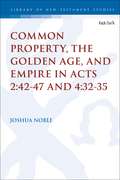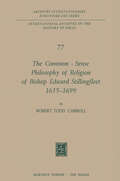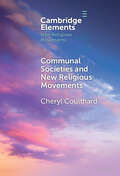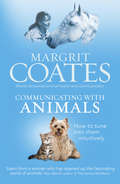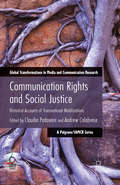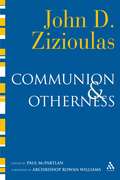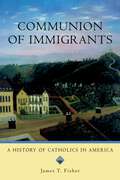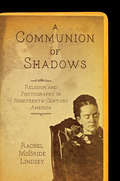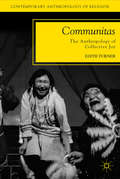- Table View
- List View
Common Property, the Golden Age, and Empire in Acts 2:42-47 and 4:32-35 (The Library of New Testament Studies)
by Joshua NobleJoshua Noble focuses on the rapid appearance and disappearance in Acts 2 and 4 of the motif that early believers hold all their property in common, and argues that these descriptions function as allusions to the Golden Age myth. Noble suggests Luke's claims that the believers “had all things in common” and that “no one claimed private ownership of any possessions” – a motif that does not appear in any biblical source - rather calls to mind Greek and Roman traditions that the earliest humans lived in utopian conditions, when “no one … possessed any private property, but all things were common.” By analysing sources from Greek, Latin, Jewish and Christian traditions, and reading Acts 2:42–47 and 4:32–35 as Golden Age Allusions, Noble illustrates how Luke's use of the motif of common property is significant for understanding his attitude toward the Roman Empire. Noble suggests that Luke's appeal to this myth accomplishes two things: it characterizes the coming of the Spirit as marking the beginning of a new age, the start of a “universal restoration” that will find its completion at the second coming of Christ; and it creates a contrast between Christ, who has actually brought about this restoration, and the emperors of Rome, who were serially credited with inaugurating a new Golden Age.
The Common School Awakening: Religion and the Transatlantic Roots of American Public Education
by David KomlineA statue of Horace Mann, erected in front of the Boston State House in 1863, declares him the "Father of the American Public School System." For over a century and a half, most narratives about early American education have taken this epithet as the truth. As Mann looms over the Boston Common, so he has also loomed over discussions of early American schooling. Other scholarship has emphasized economic factors as the main reason for the emergence of public schools. The Common School Awakening offers a new narrative about the rise of public schools in America that counters these conceptions. In this book, David Komline explains how a broad and distinctly American religious consensus emerged in the first half of the nineteenth century, allowing people from across the religious spectrum to cooperate in systematizing and professionalizing America's schools in an effort to Christianize the country. At the height of this movement, several states introduced state-sponsored teacher training colleges and concentrated government oversight of schools in offices such as the one held by Mann. Shortly thereafter, the religious consensus that had served as the foundation for this common school system disintegrated. But the system itself remained, the legacy of not just one man, but of a whole network of reformers who put into motion a transatlantic and transdenominational religious movement - the "Common School Awakening."
The Common School Awakening: Religion and the Transatlantic Roots of American Public Education
by David KomlineA statue of Horace Mann, erected in front of the Boston State House in 1863, declares him the "Father of the American Public School System." For over a century and a half, most narratives about early American education have taken this epithet as the truth. As Mann looms over the Boston Common, so he has also loomed over discussions of early American schooling. Other scholarship has emphasized economic factors as the main reason for the emergence of public schools. The Common School Awakening offers a new narrative about the rise of public schools in America that counters these conceptions. In this book, David Komline explains how a broad and distinctly American religious consensus emerged in the first half of the nineteenth century, allowing people from across the religious spectrum to cooperate in systematizing and professionalizing America's schools in an effort to Christianize the country. At the height of this movement, several states introduced state-sponsored teacher training colleges and concentrated government oversight of schools in offices such as the one held by Mann. Shortly thereafter, the religious consensus that had served as the foundation for this common school system disintegrated. But the system itself remained, the legacy of not just one man, but of a whole network of reformers who put into motion a transatlantic and transdenominational religious movement - the "Common School Awakening."
The Common-Sense Philosophy of Religion of Bishop Edward Stillingfleet 1635–1699 (International Archives of the History of Ideas Archives internationales d'histoire des idées #77)
by Robert Todd CarrollI. Reason and Religion "Si on soumet tout a la raison, notre religion n'aura rien de mysterieux et de surnaturel; si on choque les principes de la raison, notre religion sera absurde et ridicule",l In this passage from his Pensees Pascal summarizes what is perhaps the most basic problem for the defender of the reasonableness of Christianity: the necessity of upholding beliefs which Reason is incapable of judging, while at the same time claiming that those beliefs are reasonable. Pascal does not state the problem in precisely these terms regarding the limits of Reason, yet it seems clear that the dilemma he is indicating involves the question of the relation of religious beliefs to the compass of Reason. He does not, however-at least in the passage cited-indicate that the problem is a question of either/or: either Reason and no Religion, or Religion and Irrationality. Rather, he seems to be simply stating what he perceives to be a simple matter of fact. If Reason is allowed to be the judge of all Religion, then all Religion must abandon any elements that are either contrary to reason or cannot be shown to be in accord with Reason. On the other hand, if Reason is not allowed to judge Religion at all, then Religion will be absurd and ridiculous.
Commons unter Unsicherheit: Indigene Organisationen, sozial-ökologischer Wandel und Kooperation in Ecuador (Ethnologie als Praxis | Anthropology as Practice)
by Claudia KonradDer Band zeigt, dass heterogene und robuste soziale Netzwerke zum Schutz indigener Gemeinwälder beitragen. In Ecuador wird die Bewirtschaftung von Gemeinwäldern durch einen rapiden sozial-ökologischen Wandel gefährdet. Indigene Organisationen bewältigen die veränderten Einflussfaktoren, indem sie im Kontext eines staatlichen Waldschutzprogramms mit Akteur*innen unterschiedlicher Hierarchie-Ebenen und gesellschaftlicher Sektoren kooperieren. Entlang interdisziplinärer Schnittstellen zwischen der sozial-ökologischen Anpassungsforschung, der Gemeingüterforschung und der sozialen Netzwerkanalyse liefert das Buch Beiträge zur Analyse und Theorie anpassungsfähiger Commons.
A Commonwealth of Hope: Augustine's Political Thought
by Michael LambA bold new interpretation of Augustine&’s virtue of hope and its place in political lifeWhen it comes to politics, Augustine of Hippo is renowned as one of history&’s great pessimists, with his sights set firmly on the heavenly city rather than the public square. Many have enlisted him to chasten political hopes, highlighting the realities of evil and encouraging citizens instead to cast their hopes on heaven. A Commonwealth of Hope challenges prevailing interpretations of Augustinian pessimism, offering a new vision of his political thought that can also help today&’s citizens sustain hope in the face of despair.Amid rising inequality, injustice, and political division, many citizens wonder what to hope for in politics and whether it is possible to forge common hopes in a deeply polarized society. Michael Lamb takes up this challenge, offering the first in-depth analysis of Augustine&’s virtue of hope and its profound implications for political life. He draws on a wide range of Augustine&’s writings—including neglected sermons, letters, and treatises—and integrates insights from political theory, religious studies, theology, and philosophy. Lamb shows how diverse citizens, both religious and secular, can unite around common hopes for the commonwealth.Recovering this understudied virtue and situating Augustine within his political, rhetorical, and religious contexts, A Commonwealth of Hope reveals how Augustine&’s virtue of hope can help us resist the politics of presumption and despair and confront the challenges of our time.
Commun (Religion-Economy-Politics)
by Anna-Katharina Höpflinger Alexander D. Ornella Stefanie KnaussAs a basic medium of human interaction, the body is fundamental to socio-cultural communication systems, in particular the communication system of religion. This innovative and ground-breaking volume studies these systems and the role that the body plays in their organization through the perspective of the concept of body as a medium and by drawing on media and communication theory.
Commun (Religion-Economy-Politics)
by Anna-Katharina Höpflinger Alexander D. Ornella Stefanie KnaussAs a basic medium of human interaction, the body is fundamental to socio-cultural communication systems, in particular the communication system of religion. This innovative and ground-breaking volume studies these systems and the role that the body plays in their organization through the perspective of the concept of body as a medium and by drawing on media and communication theory.
Communal Societies and New Religious Movements (Elements in New Religious Movements)
by null Cheryl CoulthardPopular understanding of communal societies tends to focus on the 1960s hippie colonies and ignores the rich and long history of communalism in the United States. This Element corrects that misperception by exploring the synergy between new religious movements and communal living, including the benefits and challenges that grow out of this connection. It introduces definitions of key terms and vocabulary in the fields of new religious movements and communal studies. Discussion of major theories of communal success and the role of religion follows. The Element includes historical examples to demonstrate the ways in which new religious movements used communalism as a safe space to grow and develop their religion. The Element also analyzes why these groups have tended to experience conflicts with mainstream society.
Communalism and Sexual Violence in India: The Politics of Gender, Ethnicity and Conflict
by Megha KumarSexual violence has been a regular feature of communal conflict in India since independence in 1947. The Partition riots, which saw the brutal victimization of thousands of Hindu, Muslim and Sikh women, have so far dominated academic discussions of communal violence. This book examines the specific conditions motivating sexual crimes against women based on three of the deadliest riots that occurred in Ahmedabad city, Gujarat, in 1969, 1985 and 2002. Using an in-depth, grassroots-level analysis, Megha Kumar moves away from the predominant academic view that sees Hindu nationalist ideology as responsible for encouraging attacks on women. Instead, gendered communal violence is shown to be governed by the interaction of an elite ideology and the unique economic, social and political dynamics at work in each instance of conflict. Using government reports, Hindu nationalist publications and civil society commentaries, as well as interviews with activists, politicians and riot survivors, the book offers new insights into the factors and ideologies involved in communal violence, as well as the conditions that work to prevent sexual violence in certain riot contexts.The Politics of Sexual Violence in India will be valuable for academic researchers, Human Rights organizations, NGOs working with survivors of sexual violence and for those involved with community development and urban grassroots activism.
Communicating with Animals: How to tune into them intuitively
by Margrit CoatesMargrit Coates's new book is essential reading for anyone who loves animals and who wishes to improve their understanding of animal behaviour. One of the world's leading animal communicators and healers, Margrit has many years' experience working closely with species of all kinds - from horses, dogs and cats, to wild life, rare breeds and rescue animals. In Communicating with Animals, she draws upon her very special gift and amazing experiences to help us connect with animals too. Using intuition, insight and common sense, she shows how to tune into what they are really thinking and feeling, helping us bond with them at an incredibly deep level. Her powerful techniques range from communicating with the furry, feathered and scaly friends who share our homes, to larger animals such as horses and even Anne the Elephant, as well as other non-domestic creatures. Ultimately, Margrit's wish is for each one of us to be able to tune into all life around us. Besides practical exercises and handy tips, Communicating with Animals is brimming with heart-warming stories - making it a great read and a truly inspirational guide.
Communicatio Idiomatum: Reformation Christological Debates (Changing Paradigms in Historical and Systematic Theology)
by Richard CrossThis study offers a radical reinterpretation of the sixteenth-century Christological debates between Lutheran and Reformed theologians on the ascription of divine and human predicates to the person of the incarnate Son of God (the communicatio idiomatum). It does so by close attention to the arguments deployed by the protagonists in the discussion, and to the theologians' metaphysical and semantic assumptions, explicit and implicit. It traces the central contours of the Christological debates, from the discussion between Luther and Zwingli in the 1520s to the Colloquy of Montbéliard in 1586. Richard Cross shows that Luther's Christology is thoroughly Medieval, and that innovations usually associated with Luther-in particular, that Christ's human nature comes to share in divine attributes-should be ascribed instead to his younger contemporary Johannes Brenz. The discussion is highly sensitive to the differences between the various Luther groups-followers of Brenz, and the different factions aligned in varying ways with Melanchthon-and to the differences between all of these and the Reformed theologians. By locating the Christological discussions in their immediate Medieval background, Cross also provides a comprehensive account of the continuities and discontinuities between the two eras. In these ways, it is shown that the standard interpretations of the Reformation debates on the matter are almost wholly mistaken.
Communicatio Idiomatum: Reformation Christological Debates (Changing Paradigms in Historical and Systematic Theology)
by Richard CrossThis study offers a radical reinterpretation of the sixteenth-century Christological debates between Lutheran and Reformed theologians on the ascription of divine and human predicates to the person of the incarnate Son of God (the communicatio idiomatum). It does so by close attention to the arguments deployed by the protagonists in the discussion, and to the theologians' metaphysical and semantic assumptions, explicit and implicit. It traces the central contours of the Christological debates, from the discussion between Luther and Zwingli in the 1520s to the Colloquy of Montbéliard in 1586. Richard Cross shows that Luther's Christology is thoroughly Medieval, and that innovations usually associated with Luther-in particular, that Christ's human nature comes to share in divine attributes-should be ascribed instead to his younger contemporary Johannes Brenz. The discussion is highly sensitive to the differences between the various Luther groups-followers of Brenz, and the different factions aligned in varying ways with Melanchthon-and to the differences between all of these and the Reformed theologians. By locating the Christological discussions in their immediate Medieval background, Cross also provides a comprehensive account of the continuities and discontinuities between the two eras. In these ways, it is shown that the standard interpretations of the Reformation debates on the matter are almost wholly mistaken.
Communication Rights and Social Justice: Historical Accounts of Transnational Mobilizations (Global Transformations in Media and Communication Research - A Palgrave and IAMCR Series)
by Claudia Padovani Andrew CalabresePlacing struggles for communication rights within the broader context of human rights struggles in the twentieth and twenty-first centuries, this broad-based collection offers a rich range of illustrations of national, regional and global struggles to define communication rights as essential to human needs and happiness.
Communication Strategies for Engaging Climate Skeptics: Religion and the Environment (Routledge Advances in Climate Change Research)
by Emma Frances BloomfieldCommunication Strategies for Engaging Climate Skeptics examines the intersection of climate skepticism and Christianity and proposes strategies for engaging climate skeptics in productive conversations. Despite the scientifically established threats of climate change, there remains a segment of the American population that is skeptical of the scientific consensus on climate change and the urgent need for action. One of the most important stakeholders and conversants in environmental conversations is the religious community. While existing studies have discussed environmentalism as a factor within the religious community, this book positions religion as an important factor in environmentalism and focuses on how identities play a role in environmental conversation. Rather than thinking of religious skeptics as a single unified group, Emma Frances Bloomfield argues that it is essential to recognize there are different types of skeptics so that we can better tailor our communication strategies to engage with them on issues of the environment and climate change. To do so, this work breaks skeptics down into three main types: "separators," "bargainers," and "harmonizers." The book questions monolithic understandings of climate skepticism and considers how competing narratives such as religion, economics, and politics play a large role in climate communication. Considering recent political moves to remove climate change from official records and withdraw from international environmental agreements, it is imperative now more than ever to offer practical solutions to academics, practitioners, and the public to change the conversation. To address these concerns, this book provides both a theoretical examination of the rhetoric of religious climate skeptics and concrete strategies for engaging the religious community in conversations about the environment. This book will be of great interest to students, scholars, and practitioners of climate change science, environmental communication, environmental policy, and religion.
Communication Strategies for Engaging Climate Skeptics: Religion and the Environment (Routledge Advances in Climate Change Research)
by Emma Frances BloomfieldCommunication Strategies for Engaging Climate Skeptics examines the intersection of climate skepticism and Christianity and proposes strategies for engaging climate skeptics in productive conversations. Despite the scientifically established threats of climate change, there remains a segment of the American population that is skeptical of the scientific consensus on climate change and the urgent need for action. One of the most important stakeholders and conversants in environmental conversations is the religious community. While existing studies have discussed environmentalism as a factor within the religious community, this book positions religion as an important factor in environmentalism and focuses on how identities play a role in environmental conversation. Rather than thinking of religious skeptics as a single unified group, Emma Frances Bloomfield argues that it is essential to recognize there are different types of skeptics so that we can better tailor our communication strategies to engage with them on issues of the environment and climate change. To do so, this work breaks skeptics down into three main types: "separators," "bargainers," and "harmonizers." The book questions monolithic understandings of climate skepticism and considers how competing narratives such as religion, economics, and politics play a large role in climate communication. Considering recent political moves to remove climate change from official records and withdraw from international environmental agreements, it is imperative now more than ever to offer practical solutions to academics, practitioners, and the public to change the conversation. To address these concerns, this book provides both a theoretical examination of the rhetoric of religious climate skeptics and concrete strategies for engaging the religious community in conversations about the environment. This book will be of great interest to students, scholars, and practitioners of climate change science, environmental communication, environmental policy, and religion.
Communion and Otherness: Further Studies in Personhood and the Church
by John D. Zizioulas Paul McPartlan'Communion and otherness: how can these be reconciled?' In this wide-ranging study, the distinguished Orthodox theologian, Metropolitan John (Zizioulas) of Pergamon, seeks to answer that question. In his celebrated book, Being as Communion (1985), he emphasised the importance of communion for life and for unity. In this important companion volume he now explores the complementary fact that communion is the basis for true otherness and identity. With a constant awareness of the deepest existential questions of today, Metropolitan John probes the Christian tradition and highlights the existential concerns that already underlay the writings of the Greek fathers and the definitions of the early ecumenical councils. In a vigorous and challenging way, he defends the freedom to be other as an intrinsic characteristic of personhood, fulfilled only in communion.After a major opening chapter on the ontology of otherness, written specially for this volume, the theme is systematically developed with reference to the Trinity, Christology, anthropology and ecclesiology. Another new chapter defends the idea that the Father is cause of the Trinity, as taught by the Cappadocian fathers, and replies to criticisms of this view. The final chapter responds to the customary separation of ecclesiology from mysticism and strongly favours a mystical understanding of the body of Christ as a whole. Other papers, previously published but some not easily obtainable, are all revised for their inclusion here.This is a further contribution to dialogue on some of the most vital issues for theology and the Church from one of the leading figures in modern ecumenism.
Communion, Diversity, and Salvation: The Contribution of Jean-Marie Tillard to Systematic Ecclesiology (Ecclesiological Investigations #Vol. 10)
by Brian FlanaganQuestions surrounding the understanding of "communion" are a significant feature of much contemporary ecclesiology, but their prominence calls attention to wider questions regarding ecclesiological method. Brian Flanagan addresses the questions of how to characterize a systematic ecclesiology and the possibility of a systematic communion ecclesiology through an investigation of the concept of communion in the work of Jean-Marie Tillard, OP. Tillard's theology is noted as the most prominent Roman Catholic communion ecclesiology. Flanagan argues that Tillard contributes to systematic ecclesiology by defining the concept of communion in relation to Christology, soteriology, and theological anthropology, thereby framing an answer to the contemporary question of ecclesial unity and diversity. The book also assesses the danger of idealism in Tillard's thought, and suggests that further engagement with social scientific study of the church will help strengthen, nuance, and critique Tillard's idea of communion.
Communion, Diversity, and Salvation: The Contribution of Jean-Marie Tillard to Systematic Ecclesiology (Ecclesiological Investigations)
by Brian FlanaganQuestions surrounding the understanding of "communion" are a significant feature of much contemporary ecclesiology, but their prominence calls attention to wider questions regarding ecclesiological method. Brian Flanagan addresses the questions of how to characterize a systematic ecclesiology and the possibility of a systematic communion ecclesiology through an investigation of the concept of communion in the work of Jean-Marie Tillard, OP. Tillard's theology is noted as the most prominent Roman Catholic communion ecclesiology. Flanagan argues that Tillard contributes to systematic ecclesiology by defining the concept of communion in relation to Christology, soteriology, and theological anthropology, thereby framing an answer to the contemporary question of ecclesial unity and diversity. The book also assesses the danger of idealism in Tillard's thought, and suggests that further engagement with social scientific study of the church will help strengthen, nuance, and critique Tillard's idea of communion.
Communion of Immigrants: A History of Catholics in America (Religion in American Life)
by James T. FisherCatholicism has grown from a suppressed and persecuted outsiders' religion in the American colonies to become the nation's single largest denomination. James Fisher surveys more than four centuries of Catholics' involvement in American history, starting his narrative with one of the first Spanish expeditions to Florida, in 1528. He follows the transformation of Catholicism into one of America's most culturally and ethnically diverse religions, including the English Catholics' early settlement in Maryland, the Spanish missions to the Native Americans, the Irish and German poor who came in search of work and farmland, the proliferation of Polish and Italian communities, and the growing influx of Catholics from Latin America. The book discusses Catholic involvement in politics and conflict, from New York's Tammany Hall to the Vietnam War and abortion. Fisher highlights the critical role of women in American Catholicism--from St. Elizabeth Seton and Dorothy Day to Mother Cabrini, the first American citizen to be canonized a saint--and describes the influence of prominent American Catholics such as Cardinal John J. O'Connor, 1930s radio personality Father Charles Coughlin, President John F. Kennedy, pacifists Daniel and Philip Berrigan, activist Cesar Chavez, and author Flannery O'Connor. For this new edition, Fisher has brought the story up to date, including the latest struggles within the American church leadership.
Communion of Immigrants: A History of Catholics in America (Religion in American Life)
by James T. FisherCatholicism has grown from a suppressed and persecuted outsiders' religion in the American colonies to become the nation's single largest denomination. James Fisher surveys more than four centuries of Catholics' involvement in American history, starting his narrative with one of the first Spanish expeditions to Florida, in 1528. He follows the transformation of Catholicism into one of America's most culturally and ethnically diverse religions, including the English Catholics' early settlement in Maryland, the Spanish missions to the Native Americans, the Irish and German poor who came in search of work and farmland, the proliferation of Polish and Italian communities, and the growing influx of Catholics from Latin America. The book discusses Catholic involvement in politics and conflict, from New York's Tammany Hall to the Vietnam War and abortion. Fisher highlights the critical role of women in American Catholicism--from St. Elizabeth Seton and Dorothy Day to Mother Cabrini, the first American citizen to be canonized a saint--and describes the influence of prominent American Catholics such as Cardinal John J. O'Connor, 1930s radio personality Father Charles Coughlin, President John F. Kennedy, pacifists Daniel and Philip Berrigan, activist Cesar Chavez, and author Flannery O'Connor. For this new edition, Fisher has brought the story up to date, including the latest struggles within the American church leadership.
A Communion of Shadows: Religion and Photography in Nineteenth-Century America
by Rachel McBride LindseyWhen the revolutionary technology of photography erupted in American culture in 1839, it swiftly became, in the day's parlance, a "mania." This richly illustrated book positions vernacular photography at the center of the study of nineteenth-century American religious life. As an empirical tool, photography captured many of the signal scenes of American life, from the gold rush to the bloody battlefields of the Civil War. But photographs did not simply display neutral records of people, places, and things; rather, commonplace photographs became inscribed with spiritual meaning, disclosing, not merely signifying, a power that lay beyond.Rachel McBride Lindsey demonstrates that what people beheld when they looked at a photograph had as much to do with what lay outside the frame--theological expectations, for example--as with what the camera had recorded. Whether studio portraits tucked into Bibles, postmortem portraits with locks of hair attached, "spirit" photography, stereographs of the Holy Land, or magic lanterns used in biblical instruction, photographs were curated, beheld, displayed, and valued as physical artifacts that functioned both as relics and as icons of religious practice. Lindsey's interpretation of "vernacular" as an analytic introduces a way to consider anew the cultural, social, and material reach of religion.A multimedia collaboration with MAVCOR—Center for the Study of Material & Visual Cultures of Religion—at Yale University.
Communion With God: An uncommon dialogue
by Neale Donald WalschSix years ago, Neale Donald Walsch began a conversation - forging his own unique relationship with God - and the result was "Conversations with God" book 1, which has sold over 2 million copies worldwide. In that inspirational series, Neale Donald Walsch showed that it is up to us to begin our own conversation. The next stage, as he explained in "Friendship with God", is to take this relationship one step further. Now, with the final book in this incredible series, we learn how to take the ultimate step towards communion with god.
Communitas: The Anthropology of Collective Joy (Contemporary Anthropology of Religion)
by E. TurnerCommunitas is inspired fellowship; a group's pleasure in sharing common experiences; being 'in the zone' - as in music, sport, and work; the sense felt by a group when their life together takes on full meaning. The experience of communitas, almost beyond strict definition and with almost endless variations, often appears unexpectedly.
Communities of Devotion: Religious Orders and Society in East Central Europe, 1450–1800 (Catholic Christendom, 1300-1700)
by Maria CraciunBetween the later middle ages and the eighteenth century, religious orders were in the vanguard of reform movements within the Christian church. Recent scholarship on medieval Europe has emphasised how mendicants exercised a significant influence on the religiosity of the laity by actually shaping their spirituality and piety. In a similar way for the early modern period, religious orders have been credited with disseminating Tridentine reform, training new clergy, gaining new converts and bringing those who had strayed back into the fold. Much about this process, however, still remains unknown, particularly with regards to east central Europe. Exploring the complex relationship between western monasticism and lay society in east central Europe across a broad chronological timeframe, this collection provides a re-examination of the level and nature of interaction between members of religious orders and the communities around them. That the studies in this collection are all located in east central Europe - Transylvania, Hungary, Austria, and Bohemia- fulfils a second key aim of the volume: the examination of clerical and lay piety in a region of Europe almost entirely ignored by western scholarship. As such the volume provides an important addition to current scholarship, showcasing fresh research on a subject and region on which little has been published in English. The volume further contributes to the reintegration of eastern and western European history, expanding the existing parameters of scholarly discourse into late medieval and early modern religious practice and piety.
